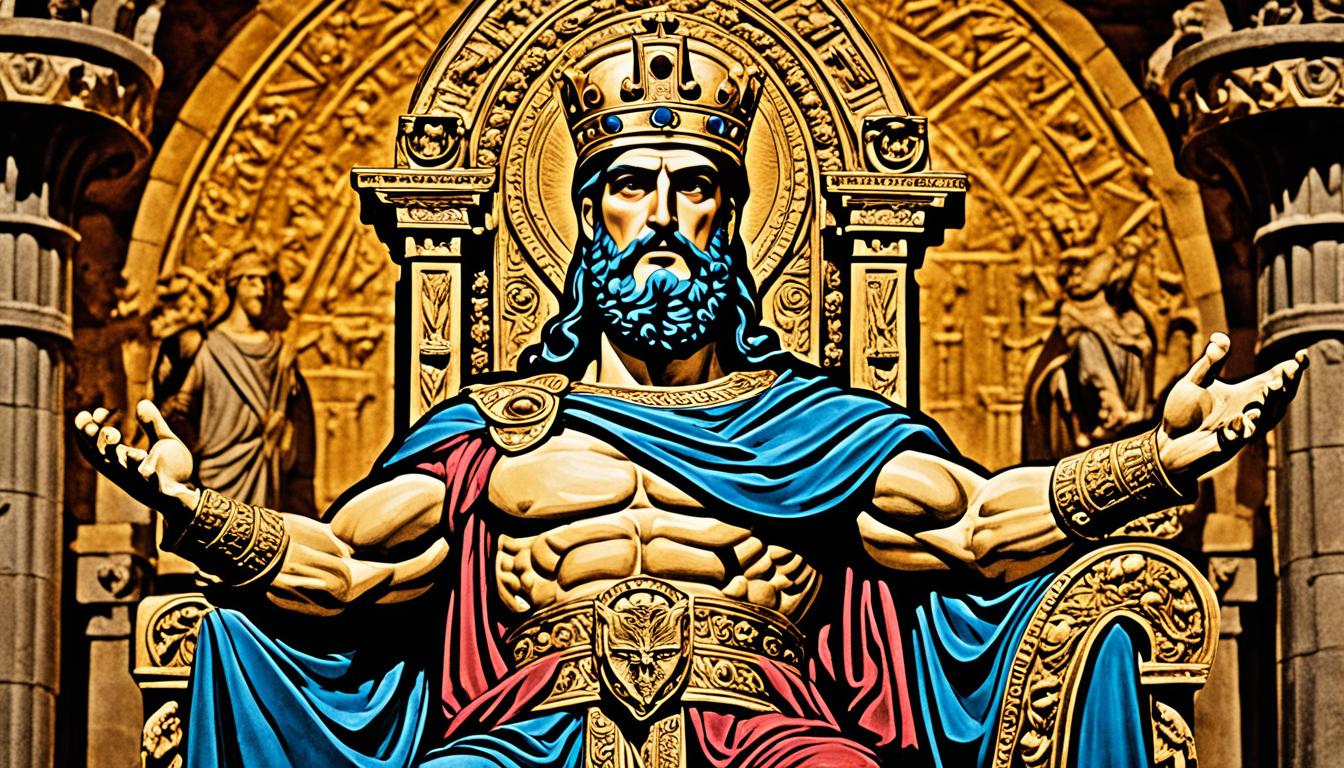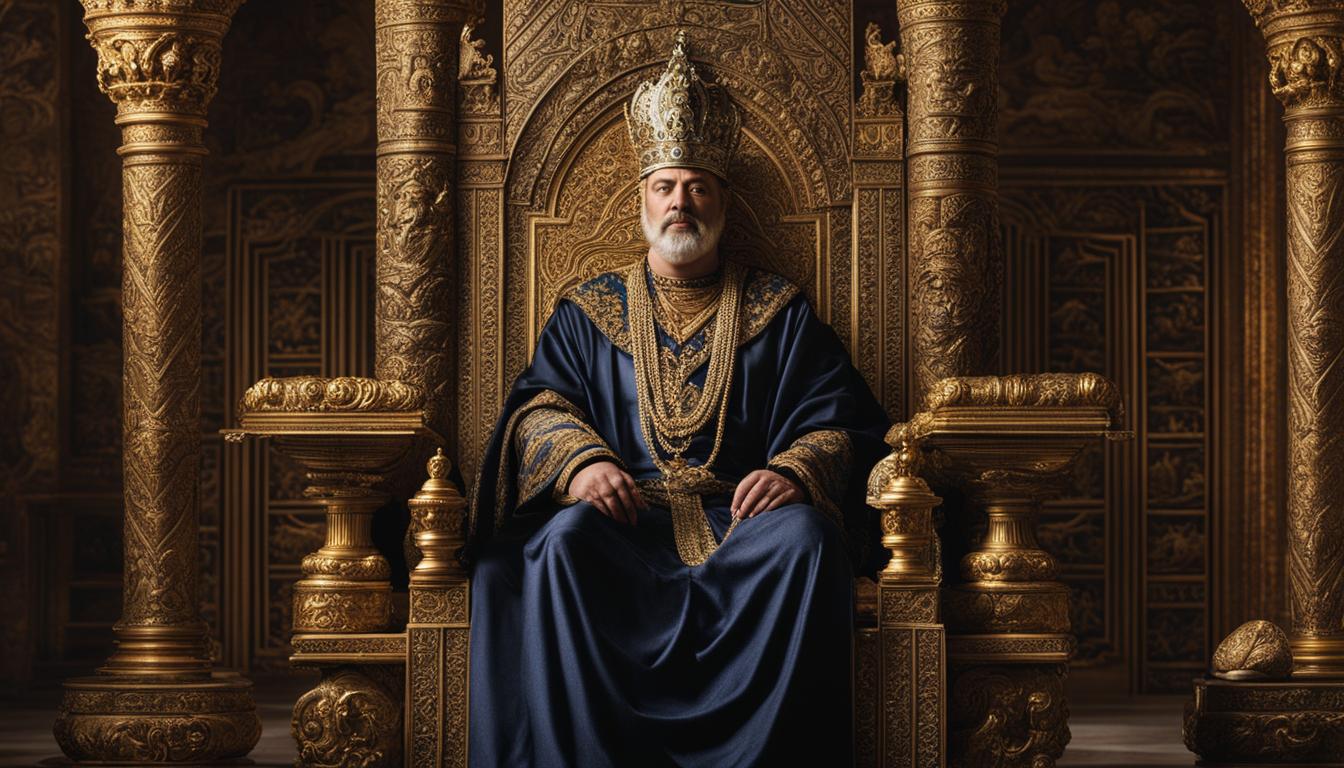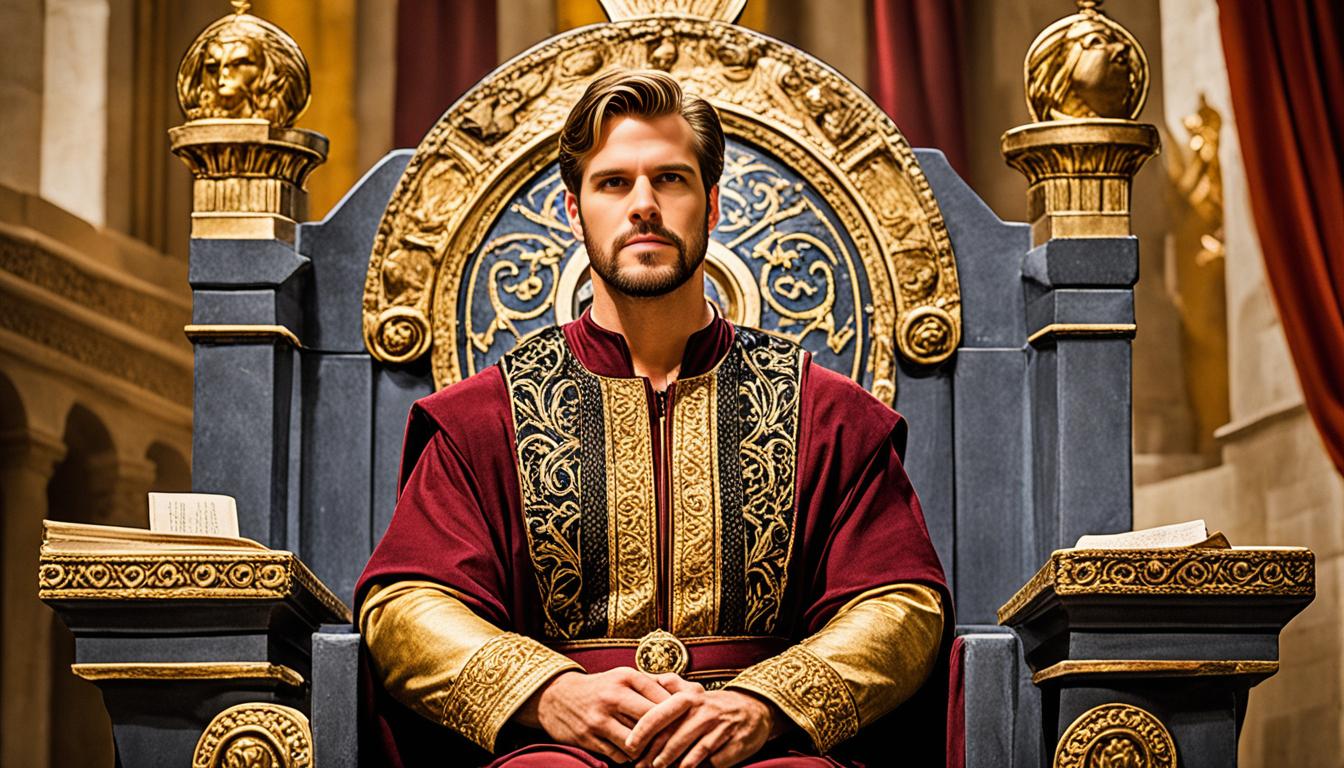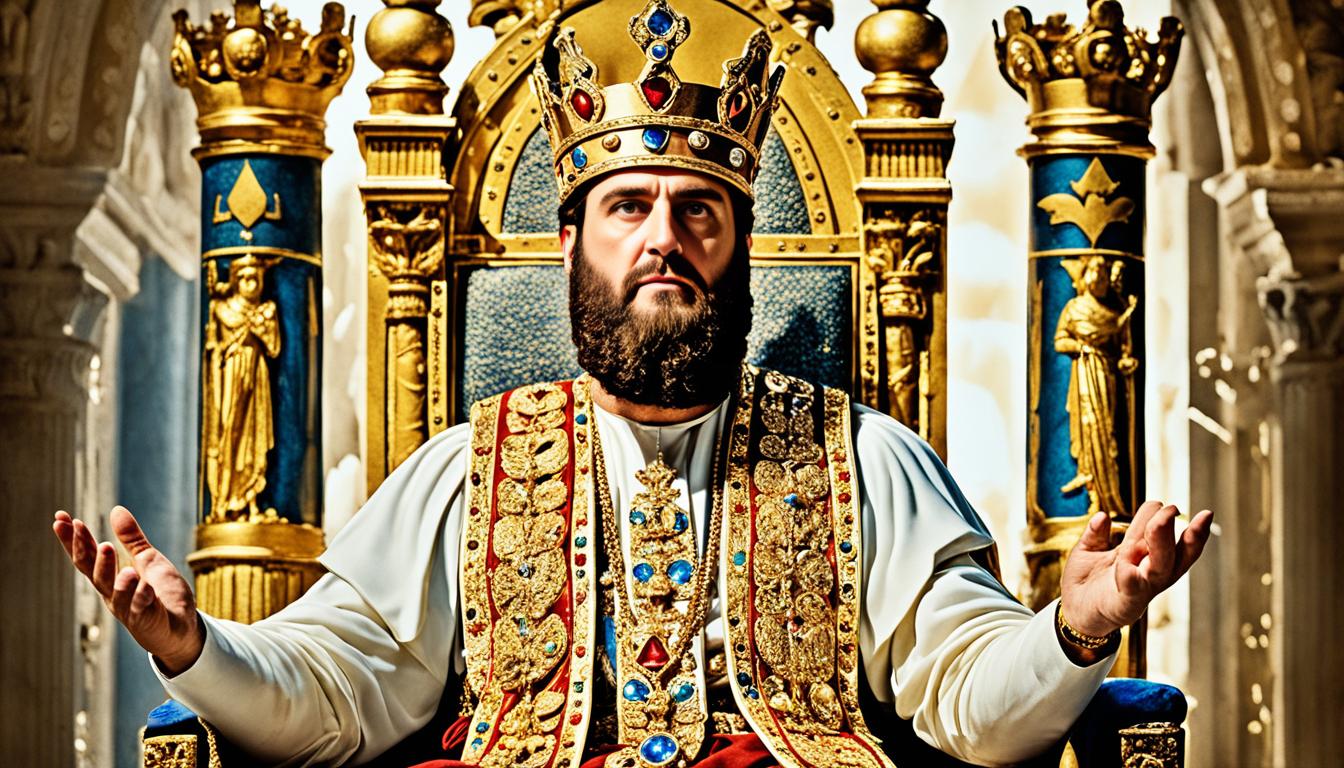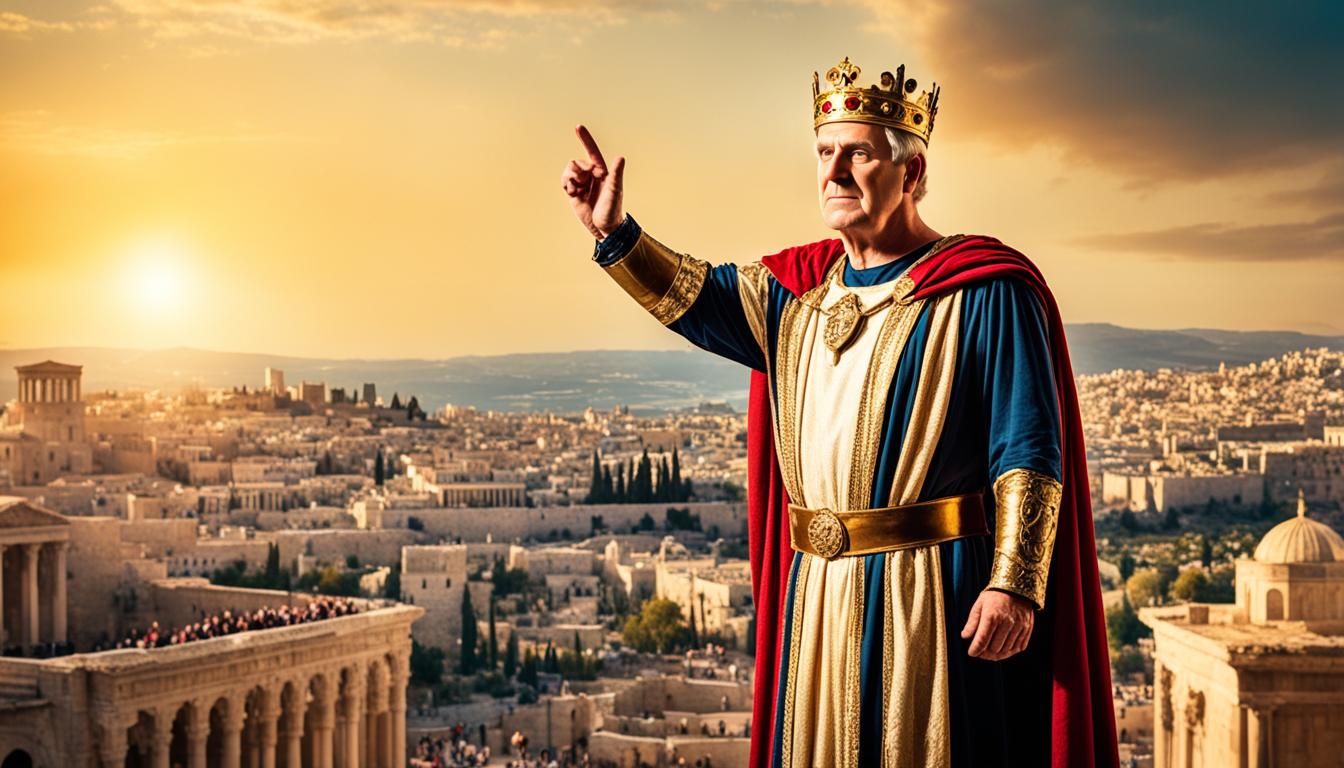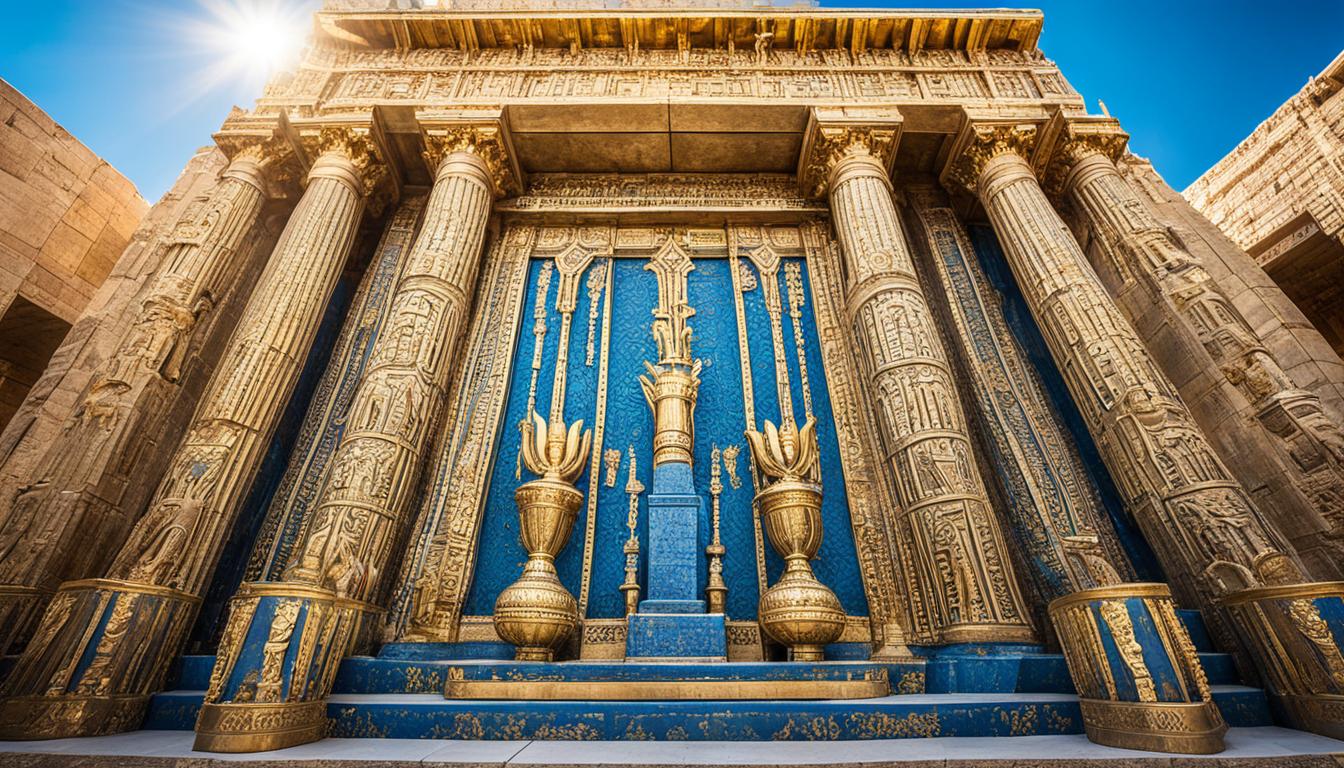Herod the Great, also known as King Herod, was a prominent figure in biblical history. He belonged to the Herodian dynasty, a ruling family appointed by the Roman Empire to govern Judea. Herod’s reign, from 37 BCE to 4 BCE, left a lasting impact on the region, both for his architectural achievements and his notorious atrocities.
Under Herod’s rule, significant historical events took place, such as the construction of Herod’s Temple and Herod’s Palace, which showcased his grandeur and ambition. However, Herod’s legacy is also tainted by his tyrannical and oppressive rule, earning him a reputation as a villain in Christian and Jewish cultures alike.
Key Takeaways:
- Herod the Great, a key figure in biblical history, was the Roman-appointed king of Judea.
- He was known for his architectural achievements, including the rebuilding of the Second Temple in Jerusalem.
- Herod’s rule was marked by controversies and brutal actions, leading to his notorious reputation.
- His relationship with the Jewish people was complex, resulting in deep mistrust.
- Despite his achievements, Herod’s legacy remains controversial, with conflicting interpretations of his reign.
Early Life and Rise to Power
Herod the Great, a significant figure in biblical history, was born in 73 BCE in Idumea, south of Judea. He was the son of Antipater, a high-ranking official under ethnarch Hyrcanus II. Herod’s rise to power can be attributed to his father’s connections with the Roman Empire, which opened up opportunities for him. In 47 BCE, Herod was appointed the governor of Galilee, a position that allowed him to establish himself as a prominent figure in the region.
Through his successful governance in Galilee, Herod gained the support and favor of key Roman figures such as Mark Antony and Octavian, who later became Emperor Augustus. Recognizing his political acumen and loyalty, they elevated Herod’s status and named him the Roman-appointed King of Judea in 40 BCE. This marked a significant turning point in Herod’s life and set the stage for his rule over Judea, which would be marked by both accomplishments and controversies.
“Herod’s rise to power can be attributed to his father’s connections with the Roman Empire, which opened up opportunities for him.”
Herod’s Rule in Judea
During his reign as the King of Judea, Herod the Great left a profound impact on the region. His rule was characterized by a mixture of remarkable accomplishments and controversial actions. Let’s explore the highlights and controversies of Herod’s rule.
Achievements in Infrastructure and Architecture
One of Herod’s notable accomplishments was his ambitious building projects. He spearheaded the reconstruction of the Second Temple in Jerusalem, transforming it into a magnificent structure. Herod’s dedication to improving Jerusalem’s defenses led to the expansion of the city’s fortifications, ensuring its security within the region. Additionally, his vision for urban development led to the creation of influential cities like Caesarea and Sebaste, adding to the region’s cultural and economic prosperity.
Controversies and Opposition
While Herod’s architectural achievements were impressive, his rule faced opposition from various Jewish factions. Many considered him a puppet ruler of the Roman Empire, fostering resentment towards him. Herod’s close ties to the Romans and his tyrannical governance fueled this perception, making him a polarizing figure among the Jewish population.
Herod’s Dilemma
Herod navigated a delicate balance between asserting his authority within the complex political landscape of the Roman Empire and appeasing the expectations of the Jewish people. His rule was a constant struggle to maintain control while preserving stability in a region marked by diverse cultural and religious traditions.
“Herod’s rule in Judea was a blend of grand achievements and challenging controversies. While his infrastructural advancements and architectural endeavors showcased his ambition, his authoritarianism and allegiance with Rome stirred unrest among the Jewish population.”
Despite the challenges and controversies he faced, Herod’s rule left an indelible mark on Judea. His architectural achievements continue to captivate historians and tourists alike, while his complex legacy invites ongoing exploration and debate.
| Herod’s Rule in Judea | Achievements | Controversies | Legacy |
|---|---|---|---|
| Reconstruction of the Second Temple | Expansion of Jerusalem’s fortifications | Perceived as a puppet of the Roman Empire | Continued influence on architecture and historical research |
| Creation of Caesarea and Sebaste | Economic and cultural prosperity | Tyrannical rule and close ties to Rome | Historical significance as a divisive ruler |
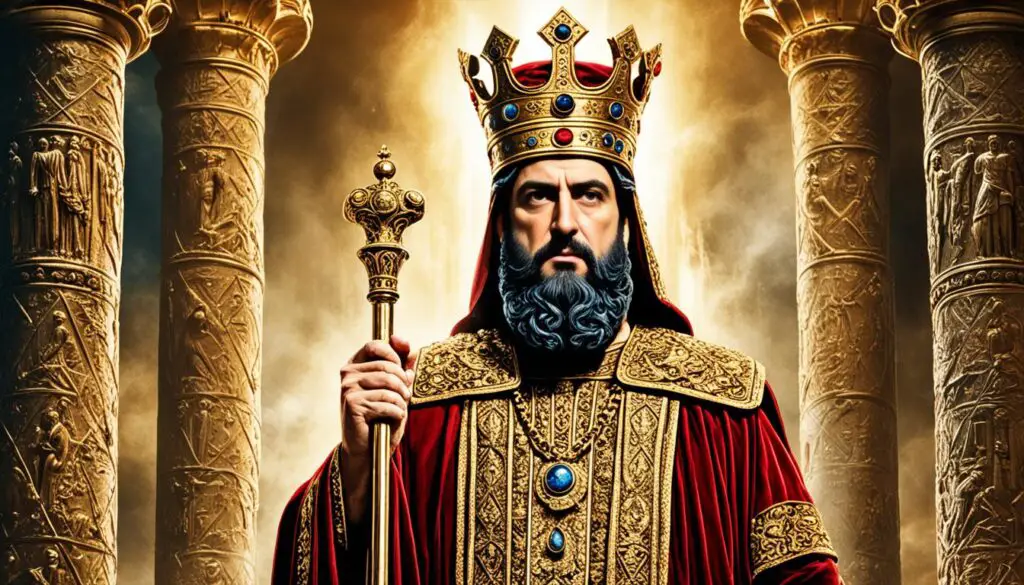
Herod’s Relationship with the Jews
Herod the Great’s relationship with the Jewish people was complex, marked by a mixture of religious practices and political alliances. While he outwardly adhered to Judaism and supported Jewish customs, his non-Jewish lineage and close affiliation with the Romans led to mistrust and suspicion among the Jewish population.
This underlying unease was exacerbated by Herod’s paranoia and acts of cruelty, further alienating the Jewish people. The combination of his despotic rule and close ties to the Romans intensified their skepticism towards his intentions, making it difficult for them to fully trust him as their leader.
One notable event that fueled the Jewish people’s distrust of Herod was the infamous “Massacre of the Innocents.” According to the Gospel of Matthew, Herod ordered the killing of all male infants in Bethlehem in an attempt to eliminate a potential threat to his reign – a newborn king who was believed to be the long-awaited Messiah.
“Then Herod, when he saw that he was deceived by the wise men, was exceedingly angry; and he sent forth and put to death all the male children who were in Bethlehem and in all its districts, from two years old and under, according to the time which he had determined from the wise men.” – Matthew 2:16
This event, although debated among scholars for its historicity, holds significant religious and cultural symbolism in Christian history. It represents a dark chapter in Herod’s rule and serves as a reminder of the Messianic expectations and the lengths to which he would go to secure his throne.
While Herod’s relationship with the Jewish people was fraught with distrust and brutality, it also reflects the complex interplay between the ruler and the religious community during that time. His actions and the resulting consequences continue to be subjects of historical and theological reflection.
Messianic Expectations and the “Massacre of the Innocents”
The Jewish people of Herod’s time lived with fervent Messianic expectations, longing for the arrival of a divinely appointed leader who would deliver them from oppression and usher in a new era of salvation.
According to Jewish belief, the Messiah would be a descendant of King David and would restore the glory of Israel. This collective hope and anticipation created a volatile backdrop against which Herod’s reign unfolded.
The “Massacre of the Innocents,” as described in the Gospel of Matthew, was a direct response to the perceived threat posed by the newborn king – the potential Messiah. By ordering the execution of innocent children, Herod sought to eliminate any competition to his reign and consolidate his grip on power.

However, it is important to note that the historicity of this event is a subject of scholarly debate. While there is biblical and historical evidence of Herod’s brutality and quest for dominance, specific details and the scale of the massacre are uncertain.
Nonetheless, the “Massacre of the Innocents” remains an indelible part of Christian tradition and a stark reminder of the challenges faced by those who openly defied Herod’s rule.
| Key Points | Discussion |
|---|---|
| Herod’s relationship with the Jews | It was marked by suspicion, fueled by his non-Jewish background and close association with the Romans. |
| The “Massacre of the Innocents” | According to the Gospel of Matthew, Herod ordered the killing of infant boys in Bethlehem to eliminate a potential threat to his reign. |
| Messianic expectations | The Jewish people eagerly anticipated the arrival of a Messiah who would deliver them from oppression and restore Israel’s glory. |
| Scholarly debate | There are differing opinions regarding the historicity and scale of the “Massacre of the Innocents.” |
Herod’s Building Projects
In addition to his controversial rule, Herod the Great was renowned for his ambitious architectural achievements. Through his grand projects, he aimed to showcase his power and solidify Roman rule in the region. Some of his notable constructions include:
The Second Temple in Jerusalem
One of Herod’s most significant undertakings was the rebuilding of the Second Temple in Jerusalem. He expanded the base of the temple and enhanced its grandeur, making it a magnificent structure that served as the center of Jewish worship.
Caesarea – A Roman-Style Port City
Herod built the city of Caesarea, known for its impressive harbor and Roman-style architecture. This port city became an important hub for trade and connectivity in the region, reflecting the advancements of Roman influence.
Sebaste – Establishing a City in Samaria
On the site of ancient Samaria, Herod established the city of Sebaste. This city showcased his power and dominance over the region and stood as a symbol of his architectural prowess.

Herod’s building projects not only served as physical manifestations of his power but also left a lasting impact on the architectural landscape of the region. From the grandeur of the Second Temple in Jerusalem to the Roman influence seen in cities like Caesarea and Sebaste, Herod’s architectural achievements continue to captivate and inspire awe.
| Herod’s Building Projects | Location |
|---|---|
| Rebuilding of the Second Temple | Jerusalem |
| Construction of Caesarea | Coastal city |
| Establishment of Sebaste | Site of ancient Samaria |
Controversies and Legacy
Herod the Great’s reign was marked by various controversies and his notorious acts, solidifying his reputation as a tyrant. In his pursuit of power, Herod didn’t shy away from executing numerous members of his own family, including his wife Mariamne. Fuelled by jealousy and paranoia, his brutal actions and oppressive rule sowed fear and resentment among his subjects. The Jewish population, in particular, grew to distrust and despise him due to his atrocities and oppressive policies.
Despite his architectural achievements and impressive building projects, such as the reconstructed Second Temple in Jerusalem and the city of Caesarea, Herod’s legacy remains incredibly divisive. Interpretations of his reign vary widely, reflecting the conflicting views surrounding his actions and his impact on the region.
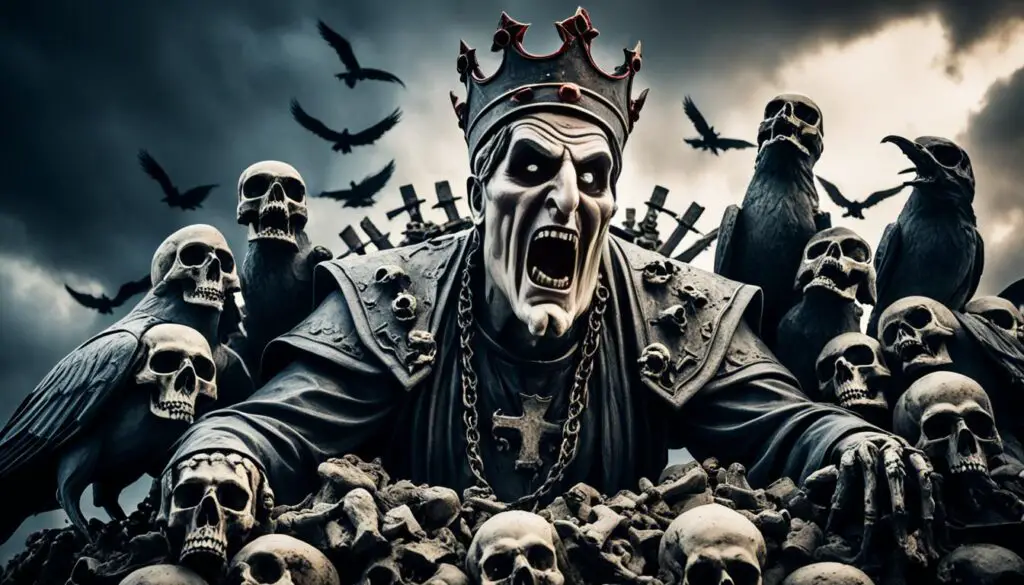
Controversial Actions and Hubris
Herod’s reign was marked by a series of controversies and atrocities. His brutal methods of maintaining control only fueled discontent among the Jewish population, as he made significant efforts to solidify Roman rule and ensure his influence. Despite his achievements in architecture, Herod’s reputation as a tyrant persisted, overshadowing any positive contributions.
“Herod’s despotic behavior exhibited a level of ruthlessness that left a lasting impact on the region. The stories of his atrocities still serve as cautionary tales today.”
Herodias: An Infamous Love Affair
One of the most scandalous controversies surrounding Herod the Great was his relationship with Herodias. She was his wife’s niece, and their adulterous affair provoked outrage among his subjects. Their scandalous union eventually led to John the Baptist’s execution, showcasing Herod’s willingness to go to great lengths to defend his pride and power.
A Divided Legacy
Herod the Great’s legacy is highly disputed. While some praise him for his architectural achievements and the economic growth he brought to the region, others condemn him for his tyrannical rule and ruthless actions. Whether he is remembered as a visionary or a villain, there is no denying the controversies that surrounded his reign and the lasting impact he had on the history of the Judean region.
Conclusion
Herod the Great, a prominent figure in the Bible, left a lasting legacy in biblical history. His reign as the Roman-appointed king of Judea showcased an intriguing blend of architectural accomplishments and a tyrannical rule. While Herod’s ambition and desire to maintain Roman power led him to construct grand structures like the Second Temple and the cities of Caesarea and Sebaste, his brutal actions and controversial governance left an indelible impact on the Judean region.
Herod’s significance in biblical history is particularly notable in relation to the birth of Jesus. According to the Gospel of Matthew, Herod’s fear of a newborn king led to the “Massacre of the Innocents” in Bethlehem. This event exemplifies the complex relationship between political rulers and religious communities.
Herod’s story serves as a cautionary tale of the perils of power and ambition. It highlights the delicate balance between maintaining political dominance and respecting the beliefs and values of religious groups. The controversies surrounding Herod’s reign and his notorious acts of cruelty have shaped his legacy and sparked discussions among scholars and believers, providing valuable insights into the intricate dynamics of biblical history.
FAQ
Who was Herod the Great and what role did he play in the Bible?
Herod the Great was the Roman-appointed king of Judaea from 37 BCE to 4 BCE. He is a significant figure in biblical history and plays a defining role in various events.
What were some of Herod the Great’s architectural achievements?
Herod the Great is known for his impressive building projects, which include the rebuilding of the Second Temple in Jerusalem, the construction of cities like Caesarea and Sebaste, and the expansion of Jerusalem’s fortifications.
How did Herod the Great’s rule impact the Jewish population?
Herod’s rule in Judea was met with mixed reactions from the Jewish population. While he supported Jewish customs and practiced Judaism outwardly, his close association with the Romans and his ethnic background raised suspicions among Jewish factions.
What is the “Massacre of the Innocents” attributed to Herod the Great?
According to the Gospel of Matthew, Herod ordered the “Massacre of the Innocents” in Bethlehem in response to the threat of a newborn king. However, the historicity of this event is debated among scholars.
What were some of Herod the Great’s most significant building projects?
Herod’s architectural achievements include the rebuilding of the Second Temple in Jerusalem, the city of Caesarea with its harbor and Roman-style architecture, and the establishment of the city of Sebaste in Samaria.
What controversies surround Herod the Great and his reign?
Herod the Great’s rule was marked by brutal actions and oppressive policies. He executed members of his own family, including his wife Mariamne, out of jealousy and paranoia, earning him a reputation as a tyrant.
What is Herod the Great’s legacy and significance in biblical history?
Herod the Great’s legacy remains controversial, with conflicting interpretations about his reign. He is remembered for his architectural achievements, but his brutal actions and oppressive rule have left a lasting impact on the Judean region.
